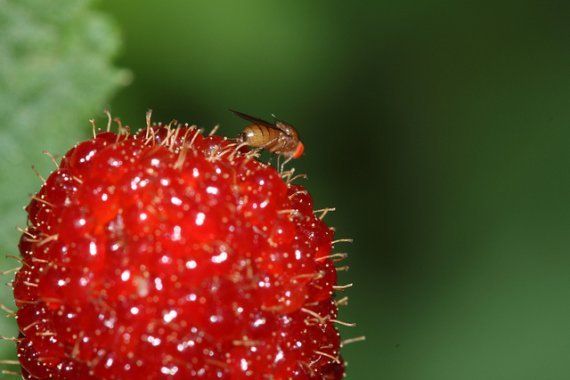© Herman Helsen
In a project funded by NWO, Groninger and Wageninger researchers studied the way of life of the Drosophila suzukii, commonly known as the spotted wing fruit fly, during spring. Adult spotted wing fruit flies survive the Dutch winter and multiply like crazy by laying eggs in ripening fruit. In March, when the temperatures rise above six or seven degrees, the flies become active, but ripening fruit is not present until summer fruit is available in late May and early June. So, what do the flies do in the meantime?
Shrubs
The researchers found that part of the spotted wing fruit flies lay eggs in the Japanese laurel (Aucuba japonica), a shrub that carries fruit in spring. The expectation was that this laurel was a springboard for the flies before moving on to the cherries. This turned out not to be the case. The larvae of the fruit flies did not develop properly in the Aucuba and were not responsible for the affection of cherries in May, the researchers noticed. They were able to discern between the darker, adult spotted wing fruit flies and the lighter-coloured spotted wing fruit flies that originated in spring in the laurel. They established that the cherry culture was affected by the darker individuals that had survived winter, not the lighter offspring.
Surviving
‘The females of the spotted wing fruit flies that are born in autumn are able to survive until June’, says Herman Helsen of Wageningen Plant Research, who was involved in the research. ‘In winter, their metabolism is low, and they eat into their egg stores and other non-vital body parts to survive. In spring, they survive by consuming yeasts and sugars, like those found in nectar. They wait for the cherry season to lay eggs.’
Fruit growers
The research provides fruit growers with important information, says Helsen. ‘The growers must realise that the flies are waiting for the first ripening cherries. The spotted wing fruit flies have been roaming the lands for months prior to that. Fruit growers use insect mesh to keep the flies out. They have to hang that mesh earlier, before the cherries start ripening. The growers must prevent that first attack; otherwise, the number of fruit flies simply explodes.’
Opportunist
By now, the spotted wing fruit fly, which was first encountered here in 2012, has become a recurring part of the picture of the Netherlands. ‘We won’t be able to get rid of it’, Helsen says. ‘It is a huge opportunist that easily switches from one type of fruit to another. They can procreate on no less than 70 host plants and can produce six generation per year.’
Weekly updates about studying and working at WUR? Subscribe to the newsletter now!

